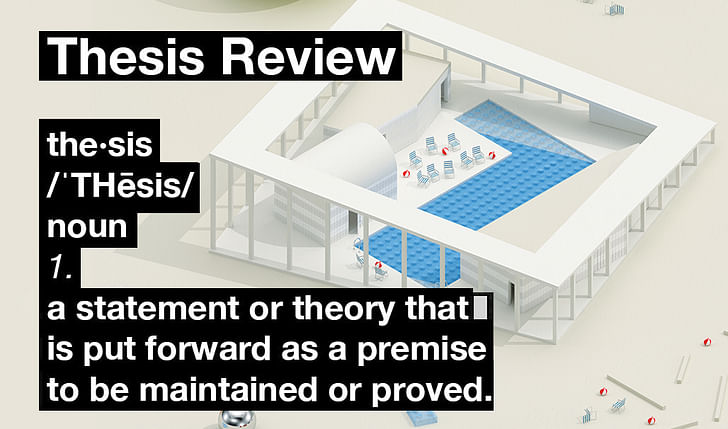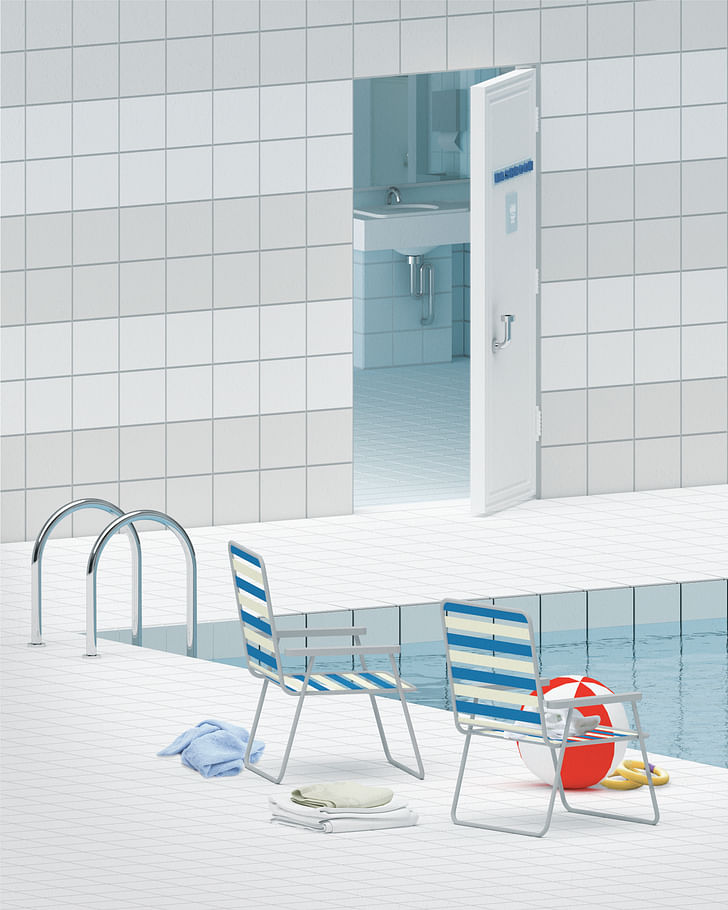

Thesis Review is a collection of conversations, statements and inquiries into the current state of thesis in academia. Thesis projects give a glimpse into the current state of the academic arena while painting a picture for the future of practice.
Each feature will present a contemporary thesis project through the voice of those that constructed it. This week, we talk to Mackenzie Muhonen about her thesis, Low Fidelity, recently presented at MIT in the Master of Architecture program.
What was the intention of your thesis? What aspect of the field of architecture/design did you want to challenge?
The thesis took the position that in the post-digital landscape, architectural images and their reproductions serve as stand-ins for firsthand experiences of buildings. In this environment, buildings are valued in fragments known as images. The layers of information intrinsic to design are excluded in the production of these images. The thesis named this condition “Low Fidelity.” It is a condition in which the image of the building supersedes the value of the building for which it speaks. The intent of the thesis was proposing methods for maneuvering within Low Fidelity. The proposed methods became chapters in a four-part essay. As an essay, the thesis interrogated facets of image culture within architecture—namely, the mediums through which images are disseminated, consumed, curated, collected, uploaded, and downloaded.
In Low Fidelity, architecture becomes a quasi-object that shifts scales, materials, and context. The labors of the architect, then, are disembodied from the building, and repositioned onto the indexes of information to destabilize the building’s image.
The thesis framed Low Fidelity as a representational crisis within architecture today. The focus was to explore methods for operating within this crisis. In a context where ‘everyone is a designer’ and can upload and access infinite images of architecture, architects must approach their work from a new angle. In the thesis, the architect is positioned as the author of new, or perhaps recast, labors in Low Fidelity. The architect scripts the link between divergent and infinitely accessible architectural content by designing the indexes that seam spatial fragments together. Architectural images and their reproductions become compositions of built up layers of information, which are detached from their original context to gain new meaning. In Low Fidelity, architecture becomes a quasi-object that shifts scales, materials, and context. The labors of the architect, then, are disembodied from the building, and repositioned onto the indexes of information to destabilize the building’s image.

What was the inspiration for your thesis?
The digital waste that saturates our daily lives was an endless supply of inspiration for this project. Selfies, stock photos, memes, hashtags, fake news, trolls, Insta influencers, and bots (to name a few) are some examples of the broader, image-centric condition I was trying to understand. I was looking at these variables as red flags of the aforementioned crisis facing architecture. These variables inundate our digital existences, but have been largely left out of disciplinary conversations (…though this seems to be changing with younger architects like @sssscavvvv and @malapartecafe). My interest in this project was bringing these topics into a disciplinary conversation. I wanted to take the authors of the selfie, the meme, the hashtag seriously. I wanted to frame their participation in the production of images as opportunities for architects to rethink architectural representation and the design process.
How did your thesis change over the course of a year?
I began this project with a title, but with no notion for site, program, audience, etc… It began with “Low Fidelity,” which I named as the condition in which we communicate and consume architectural content today. I identified this condition as an image-based investigation, without necessarily knowing what sort of content I wanted to produce or what type of problem I needed to use architecture to ‘solve.’ I just knew I had a series of questions I wanted to work around. I wanted to use thesis as an opportunity to explore these questions.
So within the span of a semester, the project evolved through a series of explorations that unpacked these questions. These were the four chapters, and titled “probes” that posed hypotheses about contemporary modes of image consumption and production. These probes were not developed all at once in the beginning of the project. Rather, as each one was explored, more questions would emerge, new content and polemics would surface, and would shift my attention. These surfacing topics would be explored in the next probe, and so on. Each probe could not have developed without the research generated in the pre-existing one.
I should have sooner embraced the critiques of this being “too contemporary” and “too ambivalent” of a project. In my opinion, both are characteristics of the Millennial condition...
Is there anything you would have done differently in producing your thesis, if given the chance?
I should have sooner embraced the critiques of this being “too contemporary” and “too ambivalent” of a project. In my opinion, both are characteristics of the Millennial condition—also descriptors for the main users of social media outlets, the sites for infinite image production. To be anything less than constantly refreshing your feed, constantly distracted, constantly overwhelmed with infinite viewpoints is to overlook the contemporary condition. It is ignorant. We live in an ambivalent state. And all of these parameters are unprecedented, and deserve questioning within architectural practice. So I wish I would have sooner ‘owned’ this aspect of the project and pushed it more…
What do you think the current state of thesis is within architectural education and how can it improve?
an exercise in exclusivity
I think the format of the thesis could use a facelift. For example, the current format of the final presentation trains architects to speak exclusively to other architects through text, drawings, models, and architect-only juries. It is an exercise in exclusivity, no matter what or who the content of the project attempts to engage. There is no room for non-architects, even if the review is held in a public forum. The next wave of theses need to upend this insularity, and propose new methods for engaging wider audiences. To me, finding different ways to give the thesis more traction outside of academia seems like an imperative step in enhancing contemporary architectural education..

4 Comments
"For example, the current format of the final presentation trains architects to speak exclusively to other architects through text, drawings, models, and architect-only juries. It is an exercise in exclusivity, no matter what or who the content of the project attempts to engage. There is no room for non-architects, even if the review is held in a public forum. The next wave of theses need to upend this insularity, and propose new methods for engaging wider audiences. To me, finding different ways to give the thesis more traction outside of academia seems like an imperative step in enhancing contemporary architectural education.."
preach
Finally—a thesis. Bravo.
From what I see here, this is either really good work (which I think it is) or just a reeaaallllyyy roundabout way of not having to design/detail anything constructable.
Either way, this sure beats the pants off of the nonsense in the recurring "Extra Extra" archinect series. Well done.
Very sloppy detailing at that edge of the pool ;)
Block this user
Are you sure you want to block this user and hide all related comments throughout the site?
Archinect
This is your first comment on Archinect. Your comment will be visible once approved.